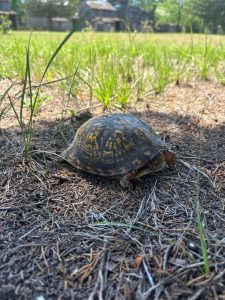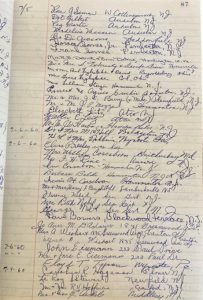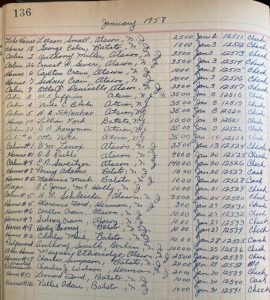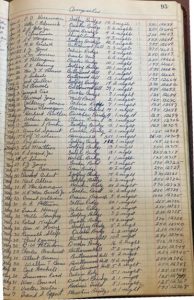Trails & Tales 0f Wharton State Forest; July 2025
"Trails & Tales of Wharton" is a new monthly publication of nature and history related articles written by Wharton State Forest's nature and history interpretive staff.
A Nature Note: How to Help Our Turtles

If you’ve explored any of our parks, forests, or historic sites you may have encounter turtles basking on rocks and logs, crawling through fields, or trying to cross our roads! We want to remind our visitors that the best way to help an uninjured turtle cross the road is to place it on the side of the road that it was heading. When you pick up a turtle, make sure you grab the rear end of its shell with both hands. If you can’t figure out what side of the road the turtle was walking towards, move it to the side with the most suitable habitat.
DO NOT move a turtle away from where you found it. Turtles often live their lives in a small area. When you move them to a new location, they will try to make their way back to their home and will likely need to cross more roads and be harmed in the process. Please note that baby turtles are not raised by their parents and should also not be moved from their habitat.
If you find an injured turtle, please call your nearest New Jersey Wildlife Rehabilitator. You can check this list for New Jersey Wildlife Rehabilitators. If you think you have encountered a rare or endangered turtle species, you can report the wildlife siting to NJ Fish and Wildlife here.
Visit the NJ Fish and Wildlife website to find out more about our wildlife and other ways you can help!
A History Highlight: Profits Versus Pacifism Splits Revolutionary Atsion
Founded by Charles Read about a decade before the start of the Revolutionary War, Atsion Forge originally refined Batsto pig iron into bar iron. The early forge at Atsion was an immediate success, producing an impressive amount of high-quality bar iron from its two forge hammers. Read, however, could not translate industrial success to financial success and quickly found himself deep in debt.
By 1773, Atsion Forge had new owners: Henry Drinker, Abel James, and Lawrence Salter. By 1774, the new business partners completed construction of a blast furnace, allowing Atsion to produce its own pig iron and operate independently from Batsto.

As business boomed in the new blast furnace and revitalized forge, the Revolutionary War brought additional challenges to Atsion. While countless other South Jersey iron manufacturers benefitted from the increased demand for wartime supplies and munitions, Atsion’s owners were divided in how they wanted to approach this emerging iron market. James and Salter saw the war as an opportunity to both support the cause for independence and make a lot of money in the process. Drinker, however, was both a Quaker and a pacifist and objected to profiting from war.
Atsion’s owners eventually came to a clever compromise: Drinker would be named manager of the furnace while Salter would be named manager of the forge. Drinker’s furnace could go out of blast, appeasing his Quaker sensibilities and reluctance to make money directly from the war. Salter’s forge, though, was kept in operation, supplying iron to the Pennsylvania Navy! By splitting Atsion’s industries, Drinker could rightly claim that he was not involved in wartime iron production while Salter and James could continue to pursue lucrative wartime production contracts.
From the Archives: Visitors and Residents and Campers... OH MY!
This month we're highlighting pages from three different ledgers. Each one offers a glimpse into the experiences of people that lived in or visited Wharton State Forest over 65 years ago.

The photo above is a page from a ledger titled “Batsto Mansion Visitors.” This book contains visitor records spanning from September 20, 1959, to June 9, 1963. Totaling 497 pages, it includes the names and hometowns of the visitors who took some of the first tours offered in Batsto Mansion! The page scanned here covers from July 5-7, 1960. It would appear that Elvis Presley was in the building on July 6… (or, more likely, someone was having a bit of fun signing the guest log before their tour!).

Here we can see who lived in Batsto, as well as the other small towns that dotted Wharton State Forest in January 1958. This ledger provides us records from
March 1952 to January 1958. Notably, Percy Adams and Maymie Etheridge appear on this page! Percy’s wife, Vera, was the last resident of Batsto, finally moving
from the village in 1989. Maymie Etheridge may be familiar to those more familiar with Atsion—she ran the General Store there from 1925 to 1951.

The last photo (with “95” printed at the top-right corner of the page) documents the hardy souls who camped in Wharton State Forest in April and May 1958… just before the start of mosquito season! Nightly campsite rates ranged between $1.25 and $1.65. There is one exception, however, when 351 visitors descended upon Harrisville, each paying $0.10 per person.
As you look through the names included in the photos, see if you can find anyone you know. Perhaps you are related to someone who lived in or visited Wharton State Forest all those years ago. You may even find yourself in the ledgers!
Today, tours of Batsto Mansion are offered year-round, Wednesday through Sunday. Campsites range from primitive sites at places like Bodine Field and Hawkins Bridge to furnished cabins at Atsion. For more information about either mansion tours or camping reservations, please call the Batsto Visitor Center at 609-561-0024.
About Wharton State Forest

Located in the Pine Barrens of New Jersey, Wharton State Forest is New Jersey's largest state forest. It encompasses approximately 125,000 acres covering parts of
Atlantic, Burlington and Camden counties providing a variety of recreational activities including hiking, biking, swimming and horseback riding. It is home to historic Batsto
Village, Batsto and Atsion Mansions, and the Atsion Recreation Area. You can find more information about Wharton State Forest and other New Jersey state parks on our
website at https://dep.nj.gov/wharton.
